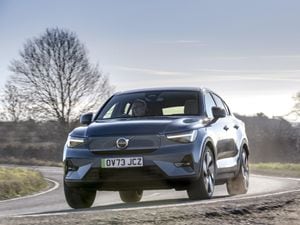UK Drive: How does McLaren’s GT cope with British roads?
McLaren’s GT aims to be capable of cross-continent journeys – but how does it get on with the cold roads of the UK in winter? Jack Evans finds out.

What is it?

When we first tested the McLaren GT towards the back end of 2019, it was on the winding, mountainous roads up and out of St Tropez in the south of France, darting in and out of tunnels as the autumn sunlight dappled the dashboard of Woking’s latest creation.
Fast forward through what could be described as a rather turbulent year and we find ourselves behind the wheel of the GT once more, albeit during a rather sodden January in the UK. The question is, how does this car – which was pitched as the useable, everyday McLaren – cope with the UK’s famously pockmarked roads during the depths of winter? We’ve been to find out.
What’s new?

The GT uses McLaren’s now tried-and-tested formula of a carbon tub with a turbocharged V8 engine mounted slap bang in the middle of the whole affair. But whereas other cars in the firm’s range celebrate that engine, the GT’s powerplant is masked by heat-blocking material which turns the whole area into a relatively long storage area. It sets the theme for the car, in truth.
Longer and more elongated than other cars in the class, the GT has been designed to fight off rivals like the Aston Martin DB11 and Bentley Continental GT for sheer cross-country supremacy. To bolster the deal even further, McLaren has also revitalised the level of standard equipment fitted to the GT, ensuring that £163,000 price tag feels more than worthwhile.
What’s under the bonnet?

The 4.0-litre twin-turbocharged V8 engine that you’ll find powering the GT is the same that you’ll spot in all other McLaren cars, but here it kicks out 612bhp and 630Nm of torque. That’s less than you’ll get from the 710bhp 720S but still more than enough to send the rear-driven GT from 0-60mph in just over three seconds and onwards to a top speed of 203mph. McLaren claims that you should get slightly more than 23mpg, while CO2 emissions stand at 270g/km.
The British firm has also lowered the engine in the GT to provide more luggage space, while also ensuring that it features enough ground clearance to deal with everyday obstacles like speed bumps and the odd kerb. A nose lift function allows you to increase the car’s height further, too.
What’s it like to drive?

When it comes to the outright driving experience, this is a McLaren through and through. All of the major control weights are expertly judged, while the brake pedal’s feel and responsiveness were one of our standout features too. That V8 engine, while not as sonorous as others in this segment, endows the GT with true supercar performance, while despite the chilly temperatures and damp surfaces getting all of that power down to the road felt more than manageable – though the traction control was working overtime, it must be said.
But as a true grand tourer the GT still feels, if anything, just too sharp. The cabin, though more heavily soundproofed than other McLarens, still resonates with the sounds of road noise while the car’s range – something we highlighted back in 2019 – still remains on the short side of things. An 80-mile round trip saw half a tank of fuel depleted, which does cut into the GT’s long-distance abilities and means that, were you allowed to undertake a grand tour of old, you’d be spending a lot of time at the fuel pump.
How does it look?

How to describe the GT’s appearance in a word: dramatic. Despite being on the so-called ‘cheaper’ end of the McLaren spectrum, this is a car which brings genuine head-turning ability and manages to draw attention to itself wherever it goes. Even ‘our’ car, in a rather stealthy all-black paint finish, failed to slip under the radar.
Then you’ve got the dihedral doors, which open up and up like a raven’s wings, and the hugely over-engineered glass ‘tailgate’ which lifts on struts above the rear of the car – all combining to create a car which provides a real amount of theatre wherever you go. It’s only just shy of the firm’s limited-edition Speedtail in terms of outright visual theatrics, in fact.
What’s it like inside?

>
Though the car’s platform may have been lifted to help it better deal with the day-to-day, the GT’s cabin remains snug and intimate. There’s just space for two, with both driver and passenger enveloped in comfortable leather-trimmed bucket seats which are low-slung yet very supportive. The electric adjustment buttons, positioned down on the corner of the chairs, take some getting used to, mind, while the steering wheel has near-endless adjustability too. Its lack of buttons or controls is pleasing to see in a world where many of the main controls have migrated onto that big circle in front of the driver.
Split between the long rear section and the handily deep section housed within the car’s nose, the GT offers up 570 litres of space. However, that glass piece lifts to reveal an area which is only really useful for flatter objects, such as coats, jackets or particularly soft weekend bags.
What’s the spec like?

As we’ve already touched upon, McLaren has increased the level of standard equipment applied to the GT. For instance, the Pioneer Pack – which includes features such as power-assisted heated memory seats, ambient lighting and leather-trimmed door sills – is now fitted as standard, rather than costing a tenner less than £10,000.
Rather than forking out an additional £3,750 for the Practicality Pack, which brings that all-important vehicle lift, rear-view camera and front and rear parking sensors (a real plus in a car as long as this), it’s now included from the off. It makes the GT far better value than before.
The seven-inch infotainment setup remains one of McLaren’s better attempts, though it’s still not quite as intuitive as rivals, particularly when it comes to elements such as pairing your phone. That said, once you’re up and running it’s reasonably easy to live with.
Verdict
Much like we found back in 2019, the GT’s issues come down to the naming. This is a wonderfully capable car with expertly-judged dynamics, just as you’d expect from a McLaren. It’s striking to look and exciting just to be around, which is exactly what you’re looking for from a car of this type.
It just isn’t as comfortable or quiet as you’d want a true GT to be. It sits firmly on the supercar-end of the scale, given its performance and the spirited driving experience it brings. However, treat the GT as a grand tourer which has been designed to exploit the twisty roads which usually form the bookends of a long journey, and it starts to make a lot more sense indeed.





